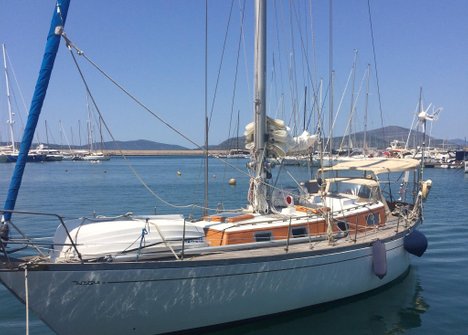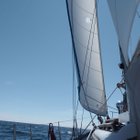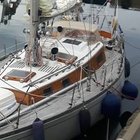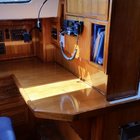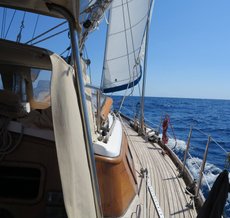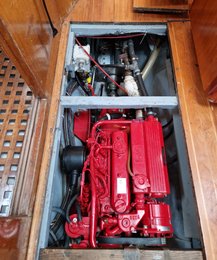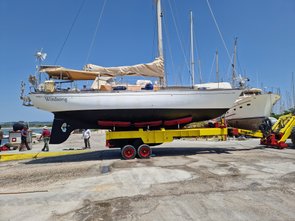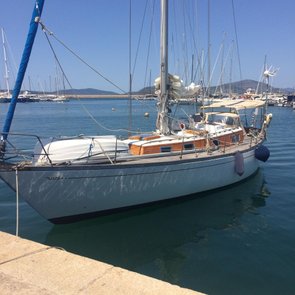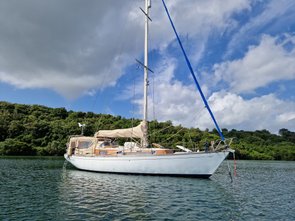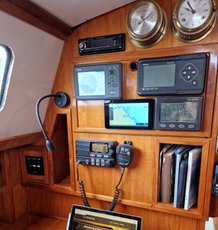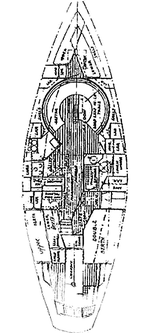The sailing yacht Windsong, of Oslo
Windsong is an Offshore 41, designed by Ray Richards and buildt by Cheoy Lee shipyards in 1978.
Some background information on the model:
Formalia:
Home port: Oslo
Call sign: LG 2436
Sail number: NOR 14067
Though formerly in the EU, she was imported to Norway, with VAT paid, in 2006.
The boat is currently in Greece.
The boat as she is
An old boat is always work in progress, but this is how she looks right now. All the main things related to seaworthiness, function and safety has been done. Some cosmetics remain...
See the below sections for an overall description, and the inventory page for a full boat inventory.
Making her go
Rigging, sails, steering, engine
Body
Deck, cockpit, and hull
Below
Accodomodations and comfort
Making her go
The boat was originally rigged as a sloop, but some previous owner has replaced all the standing rigging and converted her to a single mast sloop rig. It is of course possible to convert her back to a yawl configuration. Some preparation has even been made to add a cutter stay.
Most sails are new and/or in very good condition, including the main, trysail and gennaker (cruising spinnaker). The furling genoa nears replacement.
The main sail sheet is led to the helm, and can in the other end be attached to the cabin top in order to sail with the full bimini/enclosure. Alternatively, the original bridge deck traveller can be used.
The original Perkins 4-108 engine was in 2014 replaced with a brand new Beta 38. This was connected to the shaft via an Aquadrive, and a the fixed propeller was replaced a feathering one. All this works very well.
The boat has both a normal autopilot and a wind vane (Windpilot Pacific). The wheel is connected to the rudder via a cog-and-pinon design which works very well. The steering is very light, but still sensistive.
The classical symmetrical design of the boat (i.e., it does not have the modern very broad stern), means that the pressure on the rudder hardly changes when she leans over. This makes her very easy to balence under sail, which make the job easy for the helmsman/windvane/autopilot, even in rought seas.
Please see the Inventory page for details.
Body
The hull is made from GRP. The deck is also GRP, in two layers sanwitching a solid teak plank deck between them. On top of this, the previous owner had installed a new teak deck just before I bought the boat in 2008. The benches in the cockpit also has teak. The cabin top is solid GRP. Outside of this it is covered with thick teak planks. These are varnished. The hull, cabin top and cockpit are painted white. There is a need for filling some scratches, and a new coat of paint.
The previous owner had the hull treatedwith epoxy against osmosis at a professional boat yard in Germany (Yachtwerft Wedel, I believe). I don't know if this was a preventive measure or as a cure, but I have seen no signs of osmosis in the 15 years that I've owned the boat, even if she has sometimes been in the water for years at the time (since 2016 she has always been stored ashore in winter). There is, however, som small water ingress in the rudder. This is visible as water seeping out of the rudder during winter layup. As far as I can tell this has no structural impact on the rudder, but a new owner may choose to fix it.
The hull, cabintop and cockpit is otherwise as originally designed, with the following modifications/improvements:
Hull
- There was entirely too many through-hulls in the boat, and all those that were not actually needed were closed, under the guidance of a professional boat builder.
- All through-hulls were replaced with solid, non-corroding through-hulls and sea cocks from Forespar, made of Marelon.
- The only exception was the 2" cockpit drains which were too large. Here I used proper marine danish bronze.
- A new bulkhead has been constructed in the forepeak, providing both the rear wall of a new and larger anchor locker and a mounting point for a cutter stay.
Deck and cabin top
- The original portlights in the boat were just fitted ito holes in the cabin top and held in place by small screws from the inside. I thought this could be vulnerable to large waves, so I improved on the design.
- Most portlights were replaced with super-solid stainless steel portlights that can be opened. These were ordered from Newfound Metals in the U.S, , and has an internal and an external frame that bolt together.
- The remaining two small portlights were through-bolted to new custom exterior frames in stainless steel.
- The large aft ports (master cabin and at the chart table) were replaced with a structurally much stronger design (resting on the outside of the cabin top), and was given new polycarbonate panes and external teak trim.
- An anchor windlass and -roller from Anchorlift was added in place of the front dorade vent, and a new dorade vent was added a bit further aft.
Cockpit
- A very sturdy stainless steal framework has been custom designed and constructed for the cockpit. This consists of two pieces: The front framework over the sprayhood provides a needed handhold when the sea gets rough. It is also designed to give a sequre handhold when moving onto the deck. Finally, it supports the front end of the bimini/cockpit cover. The rear cockpit framework again provides sequirity at sea, whil also supporting the bimini. It also carries two powerful solar panels on arcs just above the bimini. In my opinion, this design is both safe and much more in style with this traditional boat than modern day biminis. Our "bimini" can be extended by modular panels to become a complete enclosure for the cockpit.
Please see the Inventory page for details.
Below
Below, the boat has the original design and content as shown in the layout picture, with the folloiwing modifications/improvements:
- All upholstery was recently replaced (2018). Under all cushion there is a air-mesh to improve ventilation, and thus prevent condensation and mold. Not so important in the Mediterranean, but very handy in colder water.
- A new anchor well has taken a bite out of the top bunk in the forepeak cabin, and that bunk is now used for storage of sails (or small children).
- One of the reasons for changing out all the windows/portlights (see "Deck and Cabin Top" under Body), was also that they were all leaking. The result of this was water damage on the interior teak plywood trim. I have replaced all the plywood on the inside of the cabin top. However, some damaged plywood still remains on some cupboards etc. There is no rot, it is just flaking teak plywood. This can be fixed with replacements or by painting. Just haven't gotten around to it yet....
- Some modifications have been made in the circular saloon to make room for an optional straight bunk there.
- The galley bench has been extended,
giving a larger sink, more bench space,
and a squared off end of the above
mentioned custom saloon bunk. - A new, seriously isolated, toploaded fridge was built into the galley bench, and the old american-style fridge converted to a cupboard.
- A new cooker/oven was installed recently.
- The chart table/nav station has been
modified and extended.
Please see the Inventory page for details.
